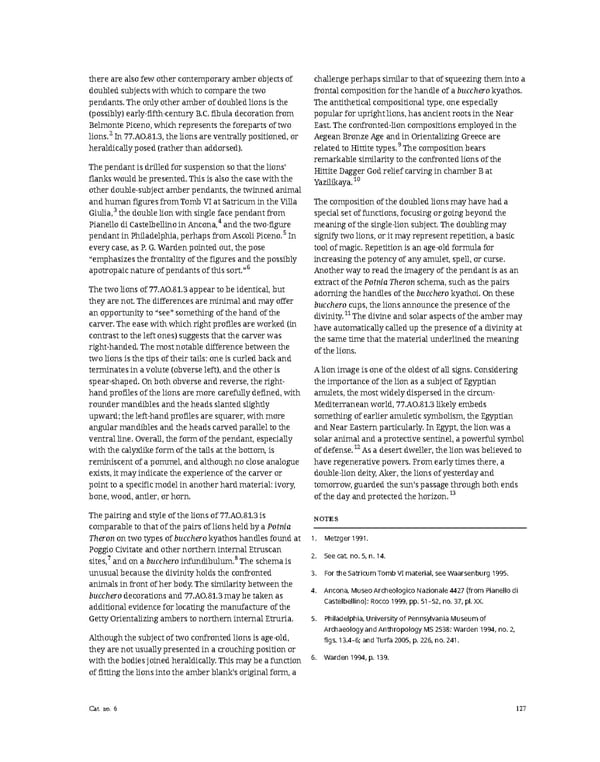there are also few other contemporary amber objects of challenge perhaps similar to that of squeezing them into a doubled subjects with which to compare the two frontal composition for the handle of a bucchero kyathos. pendants. The only other amber of doubled lions is the The antithetical compositional type, one especially (possibly) early-fifth-century B.C. fibula decoration from popular for upright lions, has ancient roots in the Near Belmonte Piceno, which represents the foreparts of two East. The confronted-lion compositions employed in the lions.2 In 77.AO.81.3, the lions are ventrally positioned, or Aegean Bronze Age and in Orientalizing Greece are heraldically posed (rather than addorsed). related to Hittite types.9 The composition bears remarkable similarity to the confronted lions of the The pendant is drilled for suspension so that the lions’ Hittite Dagger God relief carving in chamber B at flanks would be presented. This is also the case with the Yazilikaya.10 other double-subject amber pendants, the twinned animal and human figures from Tomb VI at Satricum in the Villa The composition of the doubled lions may have had a Giulia,3 the double lion with single face pendant from special set of functions, focusing or going beyond the Pianello di Castelbellino in Ancona,4 and the two-figure meaning of the single-lion subject. The doubling may pendant in Philadelphia, perhaps from Ascoli Piceno.5 In signify two lions, or it may represent repetition, a basic every case, as P. G. Warden pointed out, the pose tool of magic. Repetition is an age-old formula for “emphasizes the frontality of the figures and the possibly increasing the potency of any amulet, spell, or curse. apotropaic nature of pendants of this sort.”6 Another way to read the imagery of the pendant is as an extract of the Potnia Theron schema, such as the pairs The two lions of 77.AO.81.3 appear to be identical, but adorning the handles of the bucchero kyathoi. On these they are not. The differences are minimal and may offer buccherocups, the lions announce the presence of the an opportunity to “see” something of the hand of the divinity.11 The divine and solar aspects of the amber may carver. The ease with which right profiles are worked (in have automatically called up the presence of a divinity at contrast to the left ones) suggests that the carver was the same time that the material underlined the meaning right-handed. The most notable difference between the of the lions. two lions is the tips of their tails: one is curled back and terminates in a volute (obverse left), and the other is A lion image is one of the oldest of all signs. Considering spear-shaped. On both obverse and reverse, the right- the importance of the lion as a subject of Egyptian hand profiles of the lions are more carefully defined, with amulets, the most widely dispersed in the circum- rounder mandibles and the heads slanted slightly Mediterranean world, 77.AO.81.3 likely embeds upward; the left-hand profiles are squarer, with more something of earlier amuletic symbolism, the Egyptian angular mandibles and the heads carved parallel to the and Near Eastern particularly. In Egypt, the lion was a ventral line. Overall, the form of the pendant, especially solar animal and a protective sentinel, a powerful symbol with the calyxlike form of the tails at the bottom, is of defense.12 As a desert dweller, the lion was believed to reminiscent of a pommel, and although no close analogue have regenerative powers. From early times there, a exists, it may indicate the experience of the carver or double-lion deity, Aker, the lions of yesterday and point to a specific model in another hard material: ivory, tomorrow, guarded the sun’s passage through both ends bone, wood, antler, or horn. of the day and protected the horizon.13 The pairing and style of the lions of 77.AO.81.3 is NOTES comparable to that of the pairs of lions held by a Potnia Theronon two types of bucchero kyathos handles found at 1. Metzger 1991. Poggio Civitate and other northern internal Etruscan 2. See cat. no. 5, n. 14. sites,7 and on a bucchero infundibulum.8 The schema is unusual because the divinity holds the confronted 3. For the Satricum Tomb VI material, see Waarsenburg 1995. animals in front of her body. The similarity between the 4. Ancona, Museo Archeologico Nazionale 4427 (from Pianello di buccherodecorations and 77.AO.81.3 may be taken as Castelbellino): Rocco 1999, pp. 51–52, no. 37, pl. XX. additional evidence for locating the manufacture of the Getty Orientalizing ambers to northern internal Etruria. 5. Philadelphia, University of Pennsylvania Museum of Archaeology and Anthropology MS 2538: Warden 1994, no. 2, Although the subject of two confronted lions is age-old, figs. 13.4–6; and Turfa 2005, p. 226, no. 241. they are not usually presented in a crouching position or with the bodies joined heraldically. This may be a function 6. Warden 1994, p. 139. of fitting the lions into the amber blank’s original form, a Cat. no. 6 127
 Ancient Carved Ambers in the J. Paul Getty Museum Page 136 Page 138
Ancient Carved Ambers in the J. Paul Getty Museum Page 136 Page 138